Greetings Workateers. With pleasure I present issue No. 2. By comparison to the first, I happen to think this one's a doozy. It also happens to be full of tasty pull-quotes so I really had to reign myself in to keep this entry from being as long-winded as the last one. By example:
“Parents, do your boys trouble you in the holidays by knocking nails into the doors and carving their names on the gate? Perhaps you have never considered they have an instinctive desire to use tools. Send them for an hour a day to a carpenter, get them some tools other than the pocket-knife, and set apart an outhouse, or a dressing room, as a workshop for them; if they take to it and work with perseverance, buy them a lathe.”
Okay one more:
“Gold, jewels, and rich robes, &c, may be precious, but far more precious still are tools. Look with respect, then, gentles, at the carpenter's bench and basket of tools, at the blacksmith's anvil and vice, for you could more easily dispense with your carriages and horses, your houses and parks, than you could do without these.”
I'll confess to a particular glee in presenting this material. But then, how often in the course of a single day do we run across terms like
goniostat aquafortis copal colodion and rhymers? The last one is something of a mystery. My assumption is that it is an arcane spelling of “reamers,” but so far I've been unable to prove it. In any case, I'm having a good time with this one.
Issue No. 2 starts off with heavy emphasis in the turning department. After instructions for a homemade chuck, the succeeding article gives advice on buying your first lathe. It's a compelling overview; a lay of the lathe land, so to speak, for amateurs in the late 19th. Naturally, there's a plug for Charles Holtzapffel's “Turning and Mechanical Manipulation a house favorite in the Gramercy Shop.
I intended to skim the article, "Artistic Furniture (Easily Made & Cheaply Produced)," but I got sucked in anyway. As it turns out, the idea for the series came about when the author found himself surrounded by packing crates too nice to chop up for firewood. I was immediately reminded of
Ben's blog entry, and of the thousands of times when my shop was presented with a surplus of materials that might normally be classified as refuse. Reading further, it becomes apparent that the press described in How To Make A Wooden Copying Press also owes its existence to a recycled packing case (as well as a scavenged bench screw).
The section "Means Modes and Methods" appears for the first time in issue No. 2 and it's a hoot. I won't spoil the surprise but it elucidates the connection between horticulture and musical instrument preservation, and then proceeds to give the recipe for something called a Rust Joint.
Finally, notice is given in the section "Trade Notes and Memoranda" that one MISTER Banister Fletcher will be giving lectures on “Architecture,” with emphasis on the “practical side.” This would be thirty years before he was knighted, unless the notice actually refers to his father, an architect by the same name, and alive at the same time.
–TIM
ARTICLES FOUND IN THIS ISSUE:
A Home-Made Dog Chuck • Lathes And Turning Appliances • Sign Writing And Lettering (Part 2)
Why Does A Tool Cut? • The Bunsen Battery (Part 2)
Artistic Furniture: Easily Made And Cheaply Produced • Tips For Tyros
How To Make A Wooden Copying Press • Our Guide To Good Things
Means, Modes, and Methods • Shop: A Corner For Those Who Want To Talk It
• Click to Download Vol.1 - No.2 •
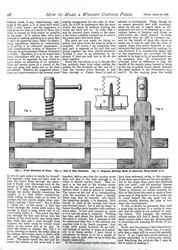
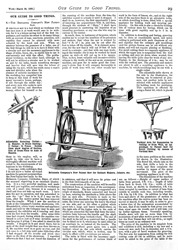
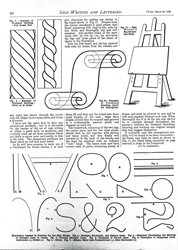
Disclaimer: Articles in Work: The Illustrated Weekly Journal for Mechanics describe materials and methods that would not be considered safe or advisable today. We are not responsible for the content of these magazines, and cannot take any responsibility for anyone attempting projects or procedures described therein.
The first issue of Work was published on March 23rd, 1889. The goal of this project is to release digital copies of the individual issues starting on the same date in 2012, effectively republishing the materials 123 years to the day from their original release.
The original printing was on thin, inexpensive paper. There are many cases of uneven inking and bleed-through from the page behind. Our copies of Work come from bound library volumes of these issues and are subject to unfavorable trimming, missing covers, etc. Please bear with us if a margin is clipped too close, or a few words are unreadable. To minimize harm to these fragile volumes, we've undertaken the task of scanning the books ourselves. We would like to thank James Vasile and Karl Fogel for their help in supplying us with a book scanner and generally enabling this project to get off the ground.
The original content is out of copyright, however, our scans and processing are not. You are welcome to download, print, and pretty much do what you want with the scan for your own personal purposes. Feel free to post a link or a copy on your blog or website. All we ask is a link back to the original project and this blog. We are not giving permission for commercial downloads or reprinting at this time.
 Joel's Blog
Joel's Blog Built-It Blog
Built-It Blog Video Roundup
Video Roundup Classes & Events
Classes & Events Work Magazine
Work Magazine














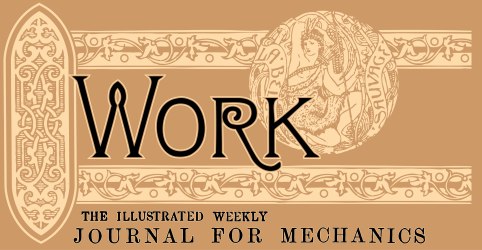
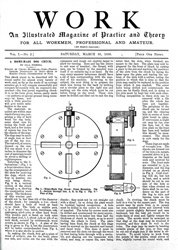



(And your captcha seems convinced that I'm a robot...)
Pops